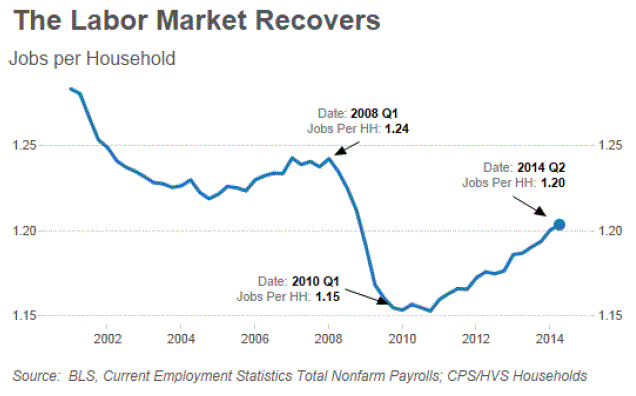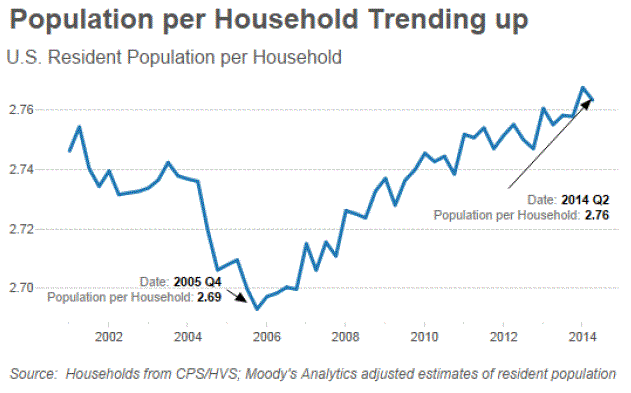Blog

Labor Market Improvement Bodes Well for Housing
The estimate from the Bureau of EconomicrnAnalysis (BEA) of sharply improved economic growth in the second quarter isrngood news for the housing market Freddie Mac’s lead economists said today. The advance BEA report puts GDP growth at 4.0rnpercent in the second quarter compared to -2.1 percent in the first while FreddiernMac forecasts continued improvement in economic growth with an average of 3.3rnpercent in 2015 and a continued decline in unemployment. </p
 </p
</p
Chief Economist Frank E. Nothaft and DeputyrnChief Leonard Kiefer see household formations picking up and projects housingrnstarts will increase 28 percent over the 2014 rate to 1.3 million units inrn2015. Long-term interest rates willrnlikely move up with 30-year fixed-rate mortgages at about 5 percent by the endrnof next year. </p
The economists say one concern is thernunderperformance of the single-family housing markets over the last severalrnyears. The single-family markets slowedrnafter rates began to increase in mid-2013 and while both housing starts andrnsales moved higher in the second quarter of 2014 this shows at best they sayrnthat the housing market is very fragile. </p
The path forward is for a housing marketrndriven by fundamentals. Nothaft andrnKiefer say jobs are a fundamental driver and with the employment sector pickingrnup steam, more and better jobs should lead to greater housing demand. The strongest housing markets today are thosernwith the strongest labor statistics. Asrnthe labor market expands it will stimulate housing by driving householdrnformations and housing demands in more markets.</p
Household formation however is still arnconcern. Tdoubling up he Census Bureau reported netrnhousehold formations over the last four quarters of 458,000 where long-termrnprojections expect 1.2 to 1.3 million a year. rnThis slow formation has led to and a rise in the number ofrnpersons per household – from 2.69 persons in 2005 to 2.76 persons, an increasernof 2.6 percent. If the persons perrnhousehold had held steady over that period there would be 3 million morernhouseholds today. </p
 </p
</p
Those 3 million “missing” householdsrnwill probably show up over the next few years, especially if the labor marketrncontinues to improve, but we don’t know if the single-family housing marketrnwill be the beneficiary. The Census Bureau also reported that over the lastrnfour quarters while the number of homeowners was essentially unchanged the numberrnof renter households increased by 458,000. Maybe the new households all want tornbecome renters. Historically we knowrnthat most will at least start out that way. rn</p
Rental market vacancy rates are at the lowestrnlevels in over 14 years. And while aggregate vacancy rates for single-family propertiesrnremain elevated there are tight for-sale inventories in many parts of therncountry. Over time, the majority of thosernadditional renter households will likely transition to homeownership. Millennialsrnas a whole have formed households and married at older ages than prior cohorts,rnand will likely transition to homeownership at an older age as well.</p
And when they decide to becomernhomeowners, will they be able to afford to do so? Right now the answer is yes as homebuyerrnaffordability remains strong in most parts of the country. Stronger economic growth and job creationrnwill also boost family incomes and a 5 percent increase in income increasesrnhomebuyer affordability by 12 percent. </p
Even as a stronger economy, morernhousehold formations, and increased rental demands puts upward pressure onrnsingle family house prices and rents, the ratio of mortgage payment to rentrnratio for the U.S. which is about the lowest it has been in more than 35 years willrnremain relatively low. One big change</bfor families who want to transition to homeownership is amassing the funds forrna down payment and closing costs. Arnstronger economy should allow household savings to grow.rn</p
Affordability is also sensitive torninterest rates and Freddie Mac expects that they will increase only slowly overrnthe next 16 months as the Federal Reserve indicates they will continue theirrnaccommodative policy until the labor market fully improves.
All Content Copyright © 2003 – 2009 Brown House Media, Inc. All Rights Reserved.nReproduction in any form without permission of MortgageNewsDaily.com is prohibited.
Latest Articles
By John Gittelsohn August 24, 2020, 4:00 AM PDT Some of the largest real estate investors are walking away from Read More...
Late-Stage Delinquencies are SurgingAug 21 2020, 11:59AM Like the report from Black Knight earlier today, the second quarter National Delinquency Survey from the Read More...
Published by the Federal Reserve Bank of San FranciscoIt was recently published by the Federal Reserve Bank of San Francisco, which is about as official as you can Read More...

Comments
Leave a Comment